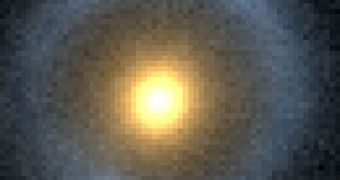In their studies of a large, distant galaxy, a team of astronomers made a very interesting finding. They were able to pinpoint the location of a very small, dwarf galaxy – in orbit around its larger counterpart. Remarkably, the smaller galaxy appears to be made exclusively out of dark matter.
Even more interesting is that the object cannot be seen with telescopes, at any wavelengths. If the structure is indeed made up of dark matter, then that could explain why it's reflecting no light at all.
Dark matter – the stuff that makes up about 23 percent of the Universe – is believed to be made up of Weakly Interacting Massive Particles (WIMP) that, as the name implies, interact very poorly with baryonic matter. In fact, astrophysicists say that the two types of matter interact only through gravity.
Astronomers discovered the tiny dark matter galaxy by analyzing how its gravitational pull is distorting light emanated by the larger galaxy. These distortions themselves are very small, yet modern technologies allow such sensitive investigations to be conducted, Space reports.
Experts believe that studies revealing objects such as this one could be used to gain a deeper understanding of the nature of dark matter. The new data could then be used to explain the large-scale structure of the Universe, the history of galaxies and other issues related to the nature of the Universe.
During the new study, experts from the University of California in Santa Barbara (UCSB) determined that the massive galaxy they were originally analyzing is located about 7 billion light-years away. This means that this is how it looked like when the Universe was less than half its current age.
What drew experts' attention was the fact that the dark matter galaxy around it weighs just 190 million solar masses. While this may seem like a lot of first, consider that the Milky Way is tens of billions of times heavier than the Sun.
“This is the lowest mass galaxy that we've seen at this distance by far,” UCSB astronomer and study coauthor Matthew Auger explains. He adds that his team used data from the Hawaii-based Keck Observatory in order to conduct the study.
This particular instrument was selected because it is outfitted with adaptive optics, a live image correction technology that allows it to compensate for how Earth's atmosphere blurs light.
“The image quality in the data we used here is somewhat better than the quality you can get from the Hubble Space Telescope,” Auger says. The team published details of their discovery in the January 19 issue of the top scientific journal Nature.

 14 DAY TRIAL //
14 DAY TRIAL //